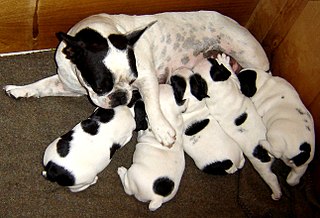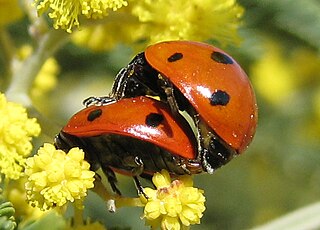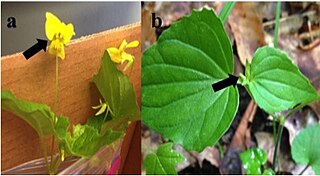Related Research Articles

Inbreeding is the production of offspring from the mating or breeding of individuals or organisms that are closely related genetically. By analogy, the term is used in human reproduction, but more commonly refers to the genetic disorders and other consequences that may arise from expression of deleterious recessive traits resulting from incestuous sexual relationships and consanguinity. Animals avoid inbreeding only rarely.

Self-pollination is a form of pollination in which pollen arrives at the stigma of a flower or at the ovule of the same plant. The term cross-pollination is used for the opposite case, where pollen from one plant moves to a different plant.

Dog breeding is the practice of mating selected dogs with the intention of maintaining or producing specific qualities and characteristics. When dogs reproduce without such human intervention, their offspring's characteristics are determined by natural selection, while "dog breeding" refers specifically to the artificial selection of dogs, in which dogs are intentionally bred by their owners. Breeding relies on the science of genetics, hence a breeder who is knowledgeable on canine genetics, health, and the intended purpose of the dogs attempts to breed suitable dogs.
Heterosis, hybrid vigor, or outbreeding enhancement is the improved or increased function of any biological quality in a hybrid offspring. An offspring is heterotic if its traits are enhanced as a result of mixing the genetic contributions of its parents. The heterotic offspring often has traits that are more than the simple addition of the parents' traits, and can be explained by Mendelian or non-Mendelian inheritance. Typical heterotic/hybrid traits of interest in agriculture are higher yield, quicker maturity, stability, drought tolerance etc.

Evolution of sexual reproduction describes how sexually reproducing animals, plants, fungi and protists could have evolved from a common ancestor that was a single-celled eukaryotic species. Sexual reproduction is widespread in eukaryotes, though a few eukaryotic species have secondarily lost the ability to reproduce sexually, such as Bdelloidea, and some plants and animals routinely reproduce asexually without entirely having lost sex. The evolution of sexual reproduction contains two related yet distinct themes: its origin and its maintenance. Bacteria and Archaea (prokaryotes) have processes that can transfer DNA from one cell to another, but it is unclear if these processes are evolutionarily related to sexual reproduction in Eukaryotes. In eukaryotes, true sexual reproduction by meiosis and cell fusion is thought to have arisen in the last eukaryotic common ancestor, possibly via several processes of varying success, and then to have persisted.
A crossbreed is an organism with purebred parents of two different breeds, varieties, or populations. A domestic animal of unknown ancestry, where the breed status of only one parent or grandparent is known, may also be called a crossbreed though the term "mixed breed" is technically more accurate. Outcrossing is a type of crossbreeding used within a purebred breed to increase the genetic diversity within the breed, particularly when there is a need to avoid inbreeding.
F1 hybrid (also known as filial 1 hybrid) is the first filial generation of offspring of distinctly different parental types. F1 hybrids are used in genetics, and in selective breeding, where the term F1 crossbreed may be used. The term is sometimes written with a subscript, as F1 hybrid. Subsequent generations are called F2, F3, etc.
Genetic load is the difference between the fitness of an average genotype in a population and the fitness of some reference genotype, which may be either the best present in a population, or may be the theoretically optimal genotype. The average individual taken from a population with a low genetic load will generally, when grown in the same conditions, have more surviving offspring than the average individual from a population with a high genetic load. Genetic load can also be seen as reduced fitness at the population level compared to what the population would have if all individuals had the reference high-fitness genotype. High genetic load may put a population in danger of extinction.
Complementation refers to a genetic process when two strains of an organism with different homozygous recessive mutations that produce the same mutant phenotype have offspring that express the wild-type phenotype when mated or crossed. Complementation will ordinarily occur if the mutations are in different genes. Complementation may also occur if the two mutations are at different sites within the same gene, but this effect is usually weaker than that of intergenic complementation. When the mutations are in different genes, each strain's genome supplies the wild-type allele to "complement" the mutated allele of the other strain's genome. Since the mutations are recessive, the offspring will display the wild-type phenotype. A complementation test can test whether the mutations in two strains are in different genes. Complementation is usually weaker or absent if the mutations are in the same gene. The convenience and essence of this test is that the mutations that produce a phenotype can be assigned to different genes without the exact knowledge of what the gene product is doing on a molecular level. American geneticist Edward B. Lewis developed the complementation test.
Inbreeding depression is the reduced biological fitness that has the potential to result from inbreeding. The loss of genetic diversity that is seen due to inbreeding, results from small population size. Biological fitness refers to an organism's ability to survive and perpetuate its genetic material. Inbreeding depression is often the result of a population bottleneck. In general, the higher the genetic variation or gene pool within a breeding population, the less likely it is to suffer from inbreeding depression, though inbreeding and outbreeding depression can simultaneously occur.
In biology, outbreeding depression happens when crosses between two genetically distant groups or populations result in a reduction of fitness. The concept is in contrast to inbreeding depression, although the two effects can occur simultaneously. Outbreeding depression is a risk that sometimes limits the potential for genetic rescue or augmentations. It is considered postzygotic response because outbreeding depression is noted usually in the performance of the progeny.
Allogamy or cross-fertilization is the fertilization of an ovum from one individual with the spermatozoa of another. By contrast, autogamy is the term used for self-fertilization. In humans, the fertilization event is an instance of allogamy. Self-fertilization occurs in hermaphroditic organisms where the two gametes fused in fertilization come from the same individual. This is common in plants and certain protozoans.

Fungi are a diverse group of organisms that employ a huge variety of reproductive strategies, ranging from fully asexual to almost exclusively sexual species. Most species can reproduce both sexually and asexually, alternating between haploid and diploid forms. This contrasts with most multicellular eukaryotes such as mammals, where the adults are usually diploid and produce haploid gametes which combine to form the next generation. In fungi, both haploid and diploid forms can reproduce – haploid individuals can undergo asexual reproduction while diploid forms can produce gametes that combine to give rise to the next generation.

Cleistogamy is a type of automatic self-pollination of certain plants that can propagate by using non-opening, self-pollinating flowers. Especially well known in peanuts, peas, and pansies, this behavior is most widespread in the grass family. However, the largest genus of cleistogamous plants is Viola.

Plant evolution is the subset of evolutionary phenomena that concern plants. Evolutionary phenomena are characteristics of populations that are described by averages, medians, distributions, and other statistical methods. This distinguishes plant evolution from plant development, a branch of developmental biology which concerns the changes that individuals go through in their lives. The study of plant evolution attempts to explain how the present diversity of plants arose over geologic time. It includes the study of genetic change and the consequent variation that often results in speciation, one of the most important types of radiation into taxonomic groups called clades. A description of radiation is called a phylogeny and is often represented by type of diagram called a phylogenetic tree.

The popular sire effect occurs when an animal with desirable attributes is bred repeatedly. In dog breeding, a male dog that wins respected competitions becomes highly sought after, as breeders believe the sire possesses the genes necessary to produce champions. However, the popular sire effect is not just down to wanting to produce a champion. For example, in Staffordshire Bull Terriers there are several popular sires who are used by breeders to produce specific colours that are not favoured in the show ring. The popular sire is often bred extensively with many females. This can cause undetected, undesirable genetic traits in the stud to spread rapidly within the gene pool. It can also reduce genetic diversity by the exclusion of other males.
Genetic purging is the increased pressure of natural selection against deleterious alleles prompted by inbreeding.
Inbreeding avoidance, or the inbreeding avoidance hypothesis, is a concept in evolutionary biology that refers to the prevention of the deleterious effects of inbreeding. Animals only rarely exhibit inbreeding avoidance. The inbreeding avoidance hypothesis posits that certain mechanisms develop within a species, or within a given population of a species, as a result of assortative mating and natural and sexual selection, in order to prevent breeding among related individuals. Although inbreeding may impose certain evolutionary costs, inbreeding avoidance, which limits the number of potential mates for a given individual, can inflict opportunity costs. Therefore, a balance exists between inbreeding and inbreeding avoidance. This balance determines whether inbreeding mechanisms develop and the specific nature of such mechanisms.
Inbreeding in fish is the mating of closely related individuals, leading to an increase in homozygosity. Repeated inbreeding generally leads to morphological abnormalities and a reduction in fitness in the offspring. In the wild, fish have a number of ways to avoid inbreeding, both before and after copulation.
Autogamy or self-fertilization refers to the fusion of two gametes that come from one individual. Autogamy is predominantly observed in the form of self-pollination, a reproductive mechanism employed by many flowering plants. However, species of protists have also been observed using autogamy as a means of reproduction. Flowering plants engage in autogamy regularly, while the protists that engage in autogamy only do so in stressful environments.
References
- 1 2 Sharp, C.A. (26 February 1999). "The Downside of Inbreeding: It's Time For a New Approach". Canine-Genetics.com. Double Helix Network News Vol. VII, No. 1 (Winter 1999). Archived from the original on 26 January 2012.
- ↑ "Feline Genetics". UC Davis Veterinary Genetics Laboratory. Archived from the original on 2009-03-12.
- ↑ Bernstein H, Byerly HC, Hopf FA, Michod RE. Genetic damage, mutation, and the evolution of sex. Science. 1985 Sep 20;229(4719):1277-81. doi: 10.1126/science.3898363. PMID 3898363
- ↑ Billiard, S.; López-Villavicencio, M.; Hood, M. E.; Giraud, T. (2012). "Sex, outcrossing and mating types: unsolved questions in fungi and beyond". Journal of Evolutionary Biology. 25 (6): 1020–1038. doi: 10.1111/j.1420-9101.2012.02495.x . PMID 22515640. S2CID 25007801.
- ↑ Xu, J. (1995). "Analysis of inbreeding depression in Agaricus bisporus". Genetics. 141 (1): 137–145. doi:10.1093/genetics/141.1.137. PMC 1206712 . PMID 8536962.
- ↑ David M. Hillis. "Inbreeding, Linebreeding, and Outcrossing in Texas Longhorns". University of Texas at Austin.
- ↑ "Mendel's Paper (English - Annotated)". www.mendelweb.org.
- ↑ "Darwin, C. R. 1876. The effects of cross and self fertilisation in the vegetable kingdom. London: John Murray". darwin-online.org.uk.
- ↑ Bernstein H, Hopf FA, Michod RE (1987). "The Molecular Basis of the Evolution of Sex". Molecular Genetics of Development. Advances in Genetics. Vol. 24. pp. 323–70. doi:10.1016/s0065-2660(08)60012-7. ISBN 9780120176243. PMID 3324702.